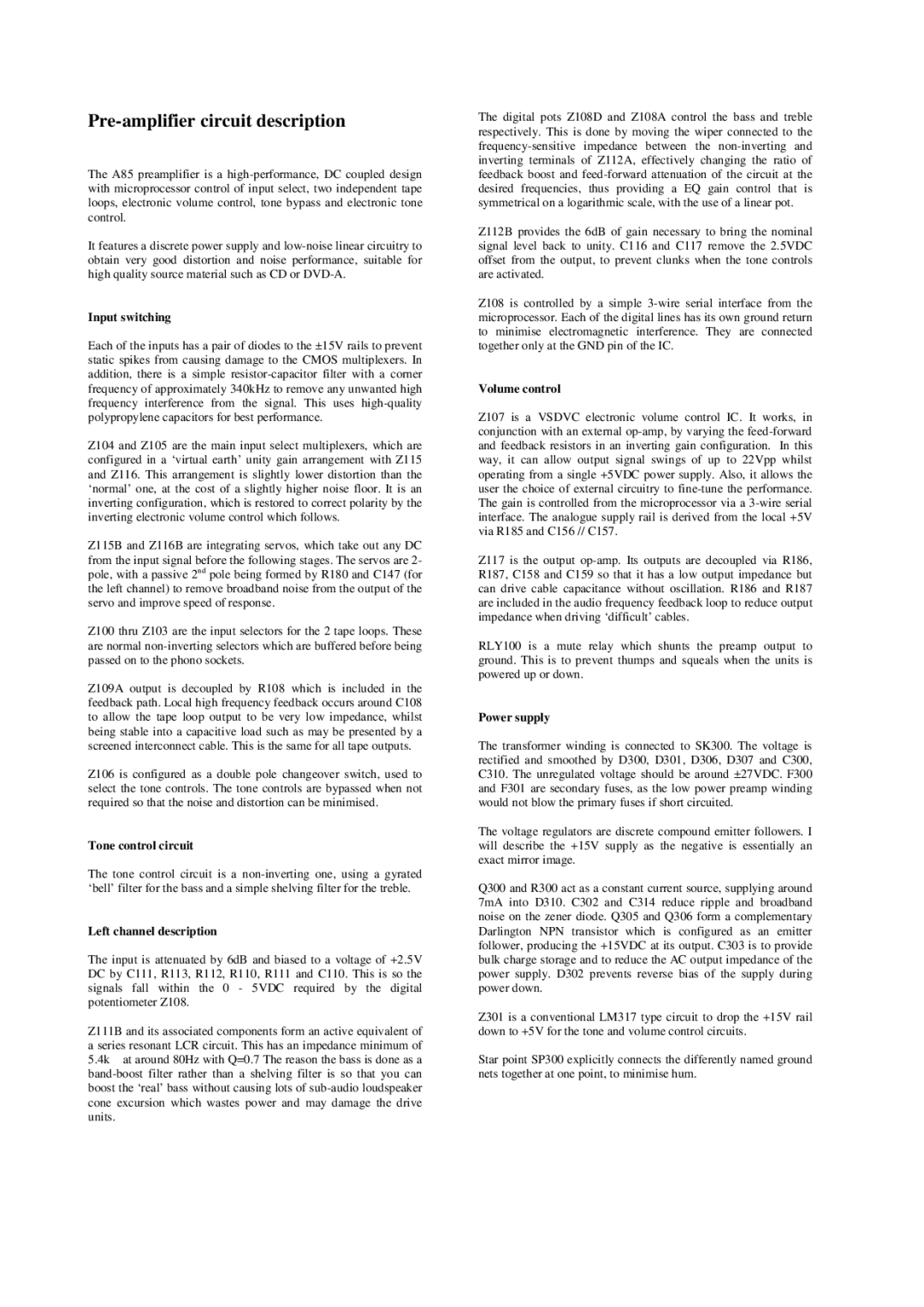Pre-amplifier circuit description
The A85 preamplifier is a high-performance, DC coupled design with microprocessor control of input select, two independent tape loops, electronic volume control, tone bypass and electronic tone control.
It features a discrete power supply and low-noise linear circuitry to obtain very good distortion and noise performance, suitable for high quality source material such as CD or DVD-A.
Input switching
Each of the inputs has a pair of diodes to the ±15V rails to prevent static spikes from causing damage to the CMOS multiplexers. In addition, there is a simple resistor-capacitor filter with a corner frequency of approximately 340kHz to remove any unwanted high frequency interference from the signal. This uses high-quality polypropylene capacitors for best performance.
Z104 and Z105 are the main input select multiplexers, which are configured in a ‘virtual earth’ unity gain arrangement with Z115 and Z116. This arrangement is slightly lower distortion than the ‘normal’ one, at the cost of a slightly higher noise floor. It is an inverting configuration, which is restored to correct polarity by the inverting electronic volume control which follows.
Z115B and Z116B are integrating servos, which take out any DC from the input signal before the following stages. The servos are 2- pole, with a passive 2nd pole being formed by R180 and C147 (for the left channel) to remove broadband noise from the output of the servo and improve speed of response.
Z100 thru Z103 are the input selectors for the 2 tape loops. These are normal non-inverting selectors which are buffered before being passed on to the phono sockets.
Z109A output is decoupled by R108 which is included in the feedback path. Local high frequency feedback occurs around C108 to allow the tape loop output to be very low impedance, whilst being stable into a capacitive load such as may be presented by a screened interconnect cable. This is the same for all tape outputs.
Z106 is configured as a double pole changeover switch, used to select the tone controls. The tone controls are bypassed when not required so that the noise and distortion can be minimised.
Tone control circuit
The tone control circuit is a non-inverting one, using a gyrated ‘bell’ filter for the bass and a simple shelving filter for the treble.
Left channel description
The input is attenuated by 6dB and biased to a voltage of +2.5V DC by C111, R113, R112, R110, R111 and C110. This is so the signals fall within the 0 - 5VDC required by the digital potentiometer Z108.
Z111B and its associated components form an active equivalent of a series resonant LCR circuit. This has an impedance minimum of 5.4k at around 80Hz with Q=0.7 The reason the bass is done as a band-boost filter rather than a shelving filter is so that you can boost the ‘real’ bass without causing lots of sub-audio loudspeaker cone excursion which wastes power and may damage the drive units.
The digital pots Z108D and Z108A control the bass and treble respectively. This is done by moving the wiper connected to the frequency-sensitive impedance between the non-inverting and inverting terminals of Z112A, effectively changing the ratio of feedback boost and feed-forward attenuation of the circuit at the desired frequencies, thus providing a EQ gain control that is symmetrical on a logarithmic scale, with the use of a linear pot.
Z112B provides the 6dB of gain necessary to bring the nominal signal level back to unity. C116 and C117 remove the 2.5VDC offset from the output, to prevent clunks when the tone controls are activated.
Z108 is controlled by a simple 3-wire serial interface from the microprocessor. Each of the digital lines has its own ground return to minimise electromagnetic interference. They are connected together only at the GND pin of the IC.
Volume control
Z107 is a VSDVC electronic volume control IC. It works, in conjunction with an external op-amp, by varying the feed-forward and feedback resistors in an inverting gain configuration. In this way, it can allow output signal swings of up to 22Vpp whilst operating from a single +5VDC power supply. Also, it allows the user the choice of external circuitry to fine-tune the performance. The gain is controlled from the microprocessor via a 3-wire serial interface. The analogue supply rail is derived from the local +5V via R185 and C156 // C157.
Z117 is the output op-amp. Its outputs are decoupled via R186, R187, C158 and C159 so that it has a low output impedance but can drive cable capacitance without oscillation. R186 and R187 are included in the audio frequency feedback loop to reduce output impedance when driving ‘difficult’ cables.
RLY100 is a mute relay which shunts the preamp output to ground. This is to prevent thumps and squeals when the units is powered up or down.
Power supply
The transformer winding is connected to SK300. The voltage is rectified and smoothed by D300, D301, D306, D307 and C300, C310. The unregulated voltage should be around ±27VDC. F300 and F301 are secondary fuses, as the low power preamp winding would not blow the primary fuses if short circuited.
The voltage regulators are discrete compound emitter followers. I will describe the +15V supply as the negative is essentially an exact mirror image.
Q300 and R300 act as a constant current source, supplying around 7mA into D310. C302 and C314 reduce ripple and broadband noise on the zener diode. Q305 and Q306 form a complementary Darlington NPN transistor which is configured as an emitter follower, producing the +15VDC at its output. C303 is to provide bulk charge storage and to reduce the AC output impedance of the power supply. D302 prevents reverse bias of the supply during power down.
Z301 is a conventional LM317 type circuit to drop the +15V rail down to +5V for the tone and volume control circuits.
Star point SP300 explicitly connects the differently named ground nets together at one point, to minimise hum.
